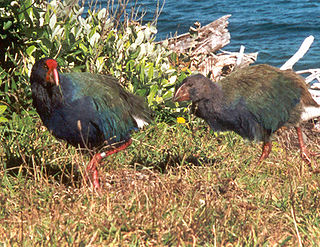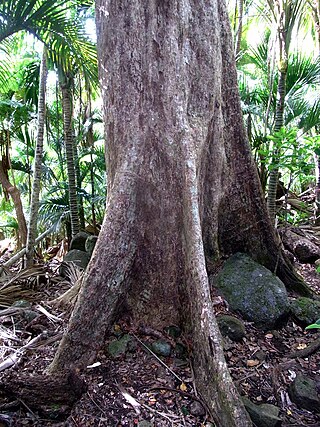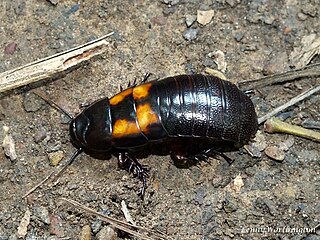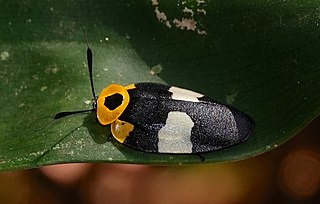
Lord Howe Island is an irregularly crescent-shaped volcanic remnant in the Tasman Sea between Australia and New Zealand, part of the Australian state of New South Wales. It lies 600 km (320 nmi) directly east of mainland Port Macquarie, 780 km (420 nmi) northeast of Sydney, and about 900 km (490 nmi) southwest of Norfolk Island. It is about 10 km (6.2 mi) long and between 0.3 and 2.0 km wide with an area of 14.55 km2, though just 3.98 km2 of that comprise the low-lying developed part of the island.

The white swamphen, also known as the Lord Howe swamphen, Lord Howe gallinule or white gallinule, is an extinct species of rail which lived on Lord Howe Island, east of Australia. It was first encountered when the crews of British ships visited the island between 1788 and 1790, and all contemporary accounts and illustrations were produced during this time. Today, two skins exist: the holotype in the Natural History Museum of Vienna, and another in Liverpool's World Museum. Although historical confusion has existed about the provenance of the specimens and the classification and anatomy of the bird, it is now thought to have been a distinct species endemic to Lord Howe Island and most similar to the Australasian swamphen. Subfossil bones have also been discovered since.

In paleontology, a Lazarus taxon is a taxon that disappears for one or more periods from the fossil record, only to appear again later. Likewise in conservation biology and ecology, it can refer to species or populations that were thought to be extinct, and are rediscovered. The term Lazarus taxon was coined by Karl W. Flessa and David Jablonski in 1983 and was then expanded by Jablonski in 1986. Paul Wignall and Michael Benton defined Lazarus taxa as, "At times of biotic crisis many taxa go extinct, but others only temporarily disappeared from the fossil record, often for intervals measured in millions of years, before reappearing unchanged". Earlier work also supports the concept though without using the name Lazarus taxon, like work by Christopher R. C. Paul.

The Lord Howe woodhen also known as the Lord Howe Island woodhen or Lord Howe (Island) rail, is a flightless bird of the rail family, (Rallidae). It is endemic to Lord Howe Island off the Australian coast. It is currently classified as endangered by the IUCN.

Cockroaches are insects belonging to the order Blattodea (Blattaria). About 30 cockroach species out of 4,600 are associated with human habitats. Some species are well-known as pests.

Lagunaria is a genus in the family Malvaceae. It is an Australian plant which is native to Lord Howe Island, Norfolk Island and parts of coastal Queensland. It has been introduced to many parts of the world. The genus was named for its resemblance to the earlier genus Laguna Cav., which was named in honour of Andrés Laguna, a Spanish botanist and a physician to Pope Julius III.

The Lord Howe flax snail or the Lord Howe placostylus, scientific name Placostylus bivaricosus, is a species of large air-breathing land snail, a terrestrial pulmonate gastropod mollusc in the family Bothriembryontidae.

The Lord Howe long-eared bat was a vespertilionid bat known only by a single specimen, a skull found on Lord Howe Island in 1972. A mammalian insectivorous species resembling the long-eared Nyctophilus, with an elongated head that is comparatively larger, about which almost nothing is known. The bat may have been casually observed in flight during the twentieth century, but is likely to have become extinct since the island's discovery and occupation. The demise of N. howensis is possibly the result of shipwrecked rats and the owls introduced to control them.
The Lord Howe Island skink is a part of the native Australian reptiles’ classification. The Lord Howe Island Skink is a species of skink in the family Scincidae, located on Australia's Norfolk Island and Lord Howe Island. The Lord Howe Island skink population is uncommon to be found on Lord Howe island, however the majority of their population is located on the Norfolk Island complex.This skink is metallic bronze in colour and has flecks for defining features. It can grow up to 8cm in length, making them medium in size. Its taxonomy is diverse, the skink is a part of the Scincidae family, Oligosoma genus. This skink population is protected and considered vulnerable under the Environment Protection and biodiversity conservation act 1999.

The Lord Howe gerygone or Lord Howe gerygone flyeater was a small bird in the family Acanthizidae, brown and greyish in color. Its head was brown apart from a pale grey eye-ring and a grey throat and chin, many parts of the animal varied to the colour of yellow, this being apparent in its bright yellow belly. It made its home in the canopies of the island's forest until the early 20th century. The bird has had a variety of monikers: locally, it was known as the "rain-bird" due to its activity after the rains, or the "pop-goes-the-weasel", due to the similarity of its song to the well-known tune. The bird was endemic to Lord Howe Island in the Tasman Sea. There have been no records of the species since 1928, and it is considered to be extinct. Its extinction is almost certainly due to predation by black rats which were accidentally introduced to the island in 1918 following the shipwreck of the SS Makambo there.
Pteropus brunneus is an extinct species of flying fox in the family Pteropodidae. It was said to be found at Percy Island, southeast of Mackay, Queensland, off the northeast coast of Australia.

The Christmas Island shrew, also known as the Christmas Island musk-shrew is an extremely rare or possibly extinct shrew from Christmas Island. It was variously placed as subspecies of the Asian gray shrew or the Southeast Asian shrew, but morphological differences and the large distance between the species indicate that it is an entirely distinct species.

Dryococelus australis, commonly known as the Lord Howe Island stick insect or tree lobster, is a species of stick insect that lives on the Lord Howe Island Group. It is the only member of the monotypic genus Dryococelus. Thought to be extinct by 1920, it was rediscovered in 2001. It is extirpated in its largest former habitat, Lord Howe Island, and has been called "the rarest insect in the world", as the rediscovered population consisted of 24 individuals living on the small islet of Ball's Pyramid.

Syzygium fullagarii, commonly known as the scalybark, is a relatively large tree in the family Myrtaceae. It is found only on Lord Howe Island. It grows to 20 metres tall, up to an altitude of 400 metres above sea level in sheltered areas, often in rainforest. The bark is reddish brown, usually flaking to the touch. The base of the tree is often heavily buttressed. Known for many years as Cleistocalyx fullagarii, however, in recent times it has been placed in the large genus Syzygium.

Mogurnda adspersa is a species of endangered gudgeon that is endemic to south-eastern mainland Australia. The fish is brown, although the shade becomes lighter near its abdomen. Spots of various colours occur on its sides. After a dramatic population decline in the late 20th century, the fish was thought to be locally extinct in several areas, but was rediscovered both in South Australia and Victoria in the 21st century. Various state governments, the Murray-Darling Basin Authority, and various volunteer organisations have been taking measures to increase the fish's numbers.

Panesthia cribrata, commonly called the Australian wood cockroach, is a wood-eating species found in rotten logs. It is found from south east Queensland south to the east coast to Tasmania, also seen at Norfolk Island. It depends on wood for sustenance, and manufactures enzymes that digest cellulose.

Panesthiinae is a subfamily of giant cockroaches (Blaberidae) mostly found in Indo-Malaysia and Australia.

Panesthia is a large genus of burrowing giant cockroach in the subfamily Panesthiinae. It is subsocial and its species are mainly found in Southeast Asia, coastal East Asia, Australasia, and Indo-Malaysia.

Panesthia australis, colloquially called the Australian wood cockroach or the common wood cockroach, is a species of giant cockroach endemic to Australia.

Eushelfordia pica is a species of cockroach in the family Ectobiidae. It is native to forests in the western Amazon basin in Ecuador, Peru and Brazil.


















